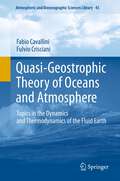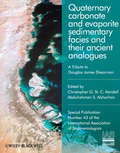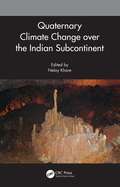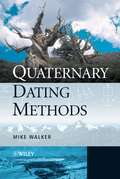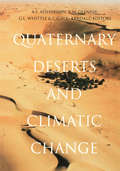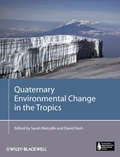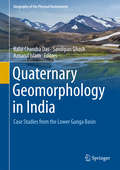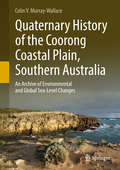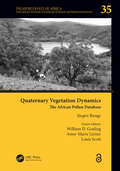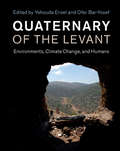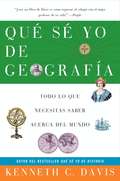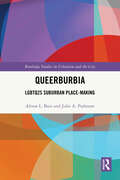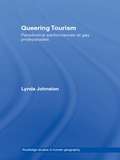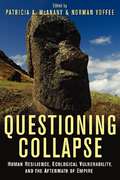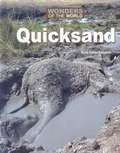- Table View
- List View
Quasi-Exactly Solvable Models in Quantum Mechanics
by A.G UshveridzeExactly solvable models, that is, models with explicitly and completely diagonalizable Hamiltonians are too few in number and insufficiently diverse to meet the requirements of modern quantum physics. Quasi-exactly solvable (QES) models (whose Hamiltonians admit an explicit diagonalization only for some limited segments of the spectrum) provide a practical way forward.Although QES models are a recent discovery, the results are already numerous. Collecting the results of QES models in a unified and accessible form, Quasi-Exactly Solvable Models in Quantum Mechanics provides an invaluable resource for physicists using quantum mechanics and applied mathematicians dealing with linear differential equations. By generalizing from one-dimensional QES models, the expert author constructs the general theory of QES problems in quantum mechanics. He describes the connections between QES models and completely integrable theories of magnetic chains, determines the spectra of QES Schrödinger equations using the Bethe-Iansatz solution of the Gaudin model, discusses hidden symmetry properties of QES Hamiltonians, and explains various Lie algebraic and analytic approaches to the problem of quasi-exact solubility in quantum mechanics.Because the applications of QES models are very wide, such as, for investigating non-perturbative phenomena or as a good approximation to exactly non-solvable problems, researchers in quantum mechanics-related fields cannot afford to be unaware of the possibilities of QES models.
Quasi-Geostrophic Theory of Oceans and Atmosphere
by Fabio Cavallini Fulvio CriscianiLarge-scale winds and currents tend to balance Coriolis and pressure gradient forces. The time evolution of these winds and currents is the subject of the quasi-geostrophic theory. Chapter 1 presents concepts and equations of classical inertial fluid mechanics. Chapter 2 deals with the equations of thermodynamics that close the governing equations of the fluids. Then, the motion is reformulated in a uniformly rotating reference frame. Chapter 3 deals with the shallow-water model and the homogeneous model of wind-driven circulation. The chapter also describes a classical application of the Ekman layer to the atmosphere. Chapter 4 considers the two-layer model, as an introduction to baroclinic flows, together with the concept of available potential energy. Chapter 5 takes into account continuously stratified flows in the ocean and in the atmosphere.
Quasi-linear Theory for Surface Wave-Current Interactions (Mathematics of Planet Earth)
by James C. McWilliamsThis book introduces a mathematical theory for the interaction of oceanic surface gravity waves and oceanic currents. This theory is formulated using the quasi-linear approximation for a uniform density fluid with a free surface and it provides wave-averaged expressions for the wave amplitudes and for the dynamical evolution of the currents. The surface gravity wave–current interaction theory is a more complete theory than previous with respect to an asymptotic expansion in the small parameter V/C, where V is a current speed and C is a wave speed. This book also illustrates the formal theory with several examples, and the path for its implementation in more realistic wave and circulation models is envisioned. This book is appealing to oceanic research scientists and mathematicians interested in geophysical fluid dynamics.
Quaternary Carbonate and Evaporite Sedimentary Facies and Their Ancient Analogues: A Tribute to Douglas James Shearman (International Association Of Sedimentologists Ser. #106)
by Tom Stevens Christopher G. St.C. Kendall Abdulrahman S. Alsharhan Ian JarvisThis book is part of the International Association of Sedimentologists (IAS) Special Publications. The Special Publications from the IAS are a set of thematic volumes edited by specialists on subjects of central interest to sedimentologists. Papers are reviewed and printed to the same high standards as those published in the journal Sedimentology and several of these volumes have become standard works of reference. This volume commemorates the eclectic research of Douglas James Shearman into evaporites, which was initiated by his studies of the prograding UAE coastal sabkhas or salt flats that incorporate evaporite minerals which displace and replace earlier carbonate sediments. His subsequent proselytization of the study of ancient evaporites in sedimentary sections all over the world led to fundamental advances in our understanding of arid zone carbonate sedimentology. The papers presented here are based on presentations made in Abu Dhabi, UAE 12-14th October 2004 and 7th –8th November 2006. They provide a retrospective from the 1960's and 70's of Holocene evaporites and carbonates, recapturing Shearman's contribution by revisiting the Holocene coastal evaporite and carbonate sediments of the Arabian/Persian Gulf from Abu Dhabi, Qatar, and Oman. The first set of papers considers these sediments from the perspective of their coastal geomorphology, sedimentary character and their geochemistry. Later papers examine the significance of these settings in the ancient geological section world-wide, including examples from the Mesozoic-Cenozoic of the Moroccan Atlantic margin and the Upper Jurassic Arab Formation of the Arabian Gulf.
Quaternary Climate Change over the Indian Subcontinent
by Neloy KhareQuaternary studies provide the essential context for evaluation of what is happening with the earth's climate today, and to clarify our vulnerability to hazardous natural processes. This book covers scientific aspects of past and present climatic changes of the quaternary period focused on the Indian subcontinent via response of modern environmental conditions on climate proxies, reconstruction of paleoclimate, paleomonsoon, glacial geology, climate variabilities using dendrochronology, cave deposits including quaternary tectonics and climate change over the Himalayan region. It consists of data generated from different landforms including lakes, caves, rivers, swamps, pits, and trenches using different proxies. Aimed at researchers, graduate students, professionals in geology, geography and environmental sciences, micropaleontology, and Quaternary climate change, this book: Studies Quaternary climate using various proxies in varied environments on the Indian sub-continent Covers pertinent historical and environmental archives to understand the current climate scenario Discusses the impact of climate change on biotic and abiotic components Includes thorough review of paleoclimate change studies Devotes significant space to glacial geology and all glacial climate proxies
Quaternary Dating Methods
by Mike WalkerThis introductory textbook introduces the basics of dating, the range of techniques available and the strengths and limitations of each of the principal methods.Coverage includes:the concept of time in Quaternary Science and related fieldsthe history of dating from lithostratigraphy and biostratigraphythe development and application of radiometric methodsdifferent methods in dating: radiometric dating, incremental dating, relative dating and age equivalencePresented in a clear and straightforward manner with the minimum of technical detail, this text is a great introduction for both students and practitioners in the Earth, Environmental and Archaeological Sciences.Praise from the reviews:"This book is a must for any Quaternary scientist." SOUTH AFRICAN GEOGRAPHICAL JOURNAL, September 2006"...very well organized, clearly and straightforwardly written and provides a good overview on the wide field of Quaternary dating methods..." JOURNAL OF QUATERNARY SCIENCE, January 2007
Quaternary Deserts and Climatic Change
by K. W. Glennie A. S. Alsharhan G. L. Whittle C.G. St.C. KENDALLThese proceedings record the results of climate change in many areas which are hyper-arid deserts today but which, almost cyclically, at intervals of thousands or even hundreds of thousands of years, have had a much more humid climate.
Quaternary Environmental Change in Southern Africa
by Knight, Jasper and Grab, Stefan W. Jasper Knight Stefan W. GrabOngoing climate change necessitates advances in our understanding of the interrelationships between climate, landscape-shaping processes and human activity over long time periods, especially in areas that are already climatically stressed. This volume presents new ideas on macroscale landscape evolution; mountain, fluvial and aeolian processes; and environments in southern Africa, a key region in the story of human evolution during the last two million years. Interdisciplinary in scope, it brings together an international team of experts to synthesise the latest research and understanding of landscape-human relationships in this region. It incorporates results from the emerging fields of geoarchaeology and cultural landscapes and utilises the latest data and analytical techniques. A key reference for researchers studying hominid evolution, geoarchaeology and environmental change, it provides a benchmark study of southern African landscape evolution during the Quaternary. It will also appeal to professionals and policymakers with interests in future human-landscape evolution in southern Africa.
Quaternary Environmental Change in the Tropics (Blackwell Quaternary Geoscience Series)
by Sarah Metcalfe David NashThe global climate changes that led to the expansion and contraction of high latitude ice sheets during the Quaternary period were associated with equally dramatic changes in tropical environments. These included shifts in vegetation zones, changes in the hydrology and ecology of lakes and rivers, and fluctuations in the size of mountain glaciers and sandy deserts. Until recently it was thought that such changes were triggered by fluctuations in the distribution of polar ice cover. Now there is increasing recognition that the tropics themselves have acted as drivers of global climate change over a range of timescales. The aim of Quaternary Environmental Change in the Tropics is to provide a synthesis of the changes that occurred in tropical terrestrial and marine systems during the Pleistocene and Holocene, complementing data-derived reconstructions with output from state-of-the-art climate models. It is targeted at final-year undergraduate students and research specialists, but will provide an introduction to tropical Quaternary research for a variety of other readers.
Quaternary Environments: Eastern Canadian Arctic, Baffin Bay and Western Greenland (Routledge Revivals)
by J. T. AndrewsFirst published in 1985, Quaternary Environments represents the culmination of Quaternary research in the region of Baffin Island, Baffin Bay and West Greenland over a period of twenty years and it will serve as a timely and complementary balance to the paleo- oceanographic studies in the NE North Atlantic. The region of Baffin Island, Baffin Bay and West Greenland is probably the best place in the world to examine the interactions between ice, land and oceans on timescales of a few hundred to many thousands of years.Two introductory chapters outline the history of research and the physical background. In Part II the evidence for glacial erosion and deposition over the eastern Canadian Arctic is examined and the history of the Baffin Island continental shelf is described. Part III deals with the paleo- oceanography of Baffin Bay and the Labrador Sea through an examination of deep-sea cores dated by several different methods. In Part IV there is a comprehensive account of the stratigraphy of Baffin Island, Bylot Island, and West Greenland, from the Pliocene to the late Wisconsin. Part V examines the climatic effects of the past 10,000 years, considering evidence from pollen analysis, glacier fluctuations, changes of sea level and the response of early (Eskimo) man.This important volume will interest all quaternary scientists, especially those in glaciology, glacial geology, marine geology, and geomorphology.
Quaternary Geomorphology in India: Case Studies From The Lower Ganga Basin (Geography of the Physical Environment)
by Balai Chandra Das Sandipan Ghosh Aznarul IslamThis edited book presents a novel collection of field-based empirical studies on the Quaternary geomorphology of the Lower Ganga Basin.The book covers a wide range of topics discussing various geomorphological facets of the Lower Ganga and its subsidiary rivers focussing on laterites, palaeoenvironment and palaeogeomorphology, palaeo-coastal landforms, neo-tectonism, tidal-fluvial dynamics, extra-channel geomorphology and channel-pattern adjustment among others. Various methodologies were applied ranging from historical records and religious texts to state-of-the-art remote sensing and GIS techniques. The book appeals to all scientists and post-graduate students of geomorphology and related areas who want to acquire detailed knowledge of the geology and geomorphology of the Lower Ganga Basin or are in search of new methodologies for studying the feedback mechanisms between forms and processes.
Quaternary History of the Coorong Coastal Plain, Southern Australia: An Archive Of Environmental And Global Sea-level Changes
by Colin V. Murray-WallaceThis book provides an up-to-date overview of the Quaternary geological and geomorphological evolution of the Coorong Coastal Plain region and its significance in a global context for understanding long-term records of Quaternary sea-level changes.The Coorong Coastal Plain in southern Australia is a natural laboratory for examining the response of coastal barrier landscapes to relative sea-level changes. The region provides direct evidence of coastal sedimentation during successive interglacials over the past 1 million years, as well as more recent volcanism. The region has received international focus and attracted scientists from around the World, with interests in long-term coastal evolution, sea-level changes, Quaternary dating methods and geochronology, soil development, temperate carbonate sedimentation, karst geomorphology and geologically recent volcanism.
Quaternary Sea-Level Changes
by Colin V. Murray-Wallace Colin D. WoodroffeThere have been significant changes in sea level over the past two million years, and a complete understanding of natural cycles of change as well as anthropogenic effects is imperative for future global development. This book reviews the history of research into these sea-level changes and summarises the methods and analytical approaches used to interpret evidence for sea-level changes. It provides an overview of changing climates during the Quaternary, examines processes responsible for global variability of sea-level records, and presents detailed reviews of sea-level changes for the Pleistocene and Holocene. The book concludes by discussing current trends in sea levels and likely future sea-level changes. This is an important and authoritative resource for academic researchers and graduate and advanced undergraduate students working in tectonics, stratigraphy, geomorphology, physical geography, environmental science and other aspects of Quaternary studies.
Quaternary Vegetation Dynamics: The African Pollen Database (Palaeoecology of Africa #35)
by Jürgen RungeThis book celebrates the relaunch of the African Pollen Database, presents state-of-the-art of modern and ancient pollen data from sub-Saharan Africa, and promotes Open Access science. Pollen grains are powerful tools for the study of past vegetation dynamics because they preserve well within sedimentary deposits and have a huge diversity in ornamentation that allows different taxa to be determined. The reconstruction of past vegetation from the examination of ancient pollen records thus can be used to characterize the nature of past landscapes (e.g. abundance of forests vs. grasslands), provide insights into changes in biodiversity, and gain empirical evidence of vegetation response to climatic change and human activity. In this, the 35th Volume of "Palaeoecology of Africa", we bring together new data and extensive synthetic reviews to provide novel insights into the relationships between human evolution, human activity, climate change and vegetation dynamics during the Quaternary, the last 2.6 million years. Current and ongoing climate and land-use change is exerting pressure on modern vegetation formations and threatening the livelihoods and wellbeing of many peoples in Africa. In this book the focus is on the Quaternary because it is during this geological period that the modern vegetation formations developed into their current configurations against a backdrop of high magnitude global climate change (glacial-interglacial cycles), human evolution, and a growing human land-use footprint. In this book the latest information is presented and collated from around the African continent to parameterize past vegetation states, identify the drivers of vegetation change, and assess the vegetation resilience to change. To achieve this research from two broad themes are covered: (i) the present is the key to the past (i.e. studies which improve our understanding of modern environments so that we can better interpret evidence from the past), and (ii) the past is the key to the future (i.e. studies which unlock information on how and why vegetation changed in the past so one can better anticipate trajectories of future change). This Open Access book will provide a strong foundation for future research exploring past ecological, environmental and climatic change within Africa and the surrounding islands. The book is organized regionally (covering western, eastern, central, and southern Africa) and it contains specialized articles focused on particular topics (such as modern pollen-vegetation relationships and fire as a driver of vegetation change), as well as regional and pan-African syntheses drawing together decades of research to assess key scientific questions (including the role of climate in driving vegetation change and the role of vegetation change in human evolution). These articles will be useful to students and teachers from high school to the highest level of university who are interested in the origins and dynamics of vegetation in Africa. Furthermore, it is also meant to provide societally relevant information that can act as an inspiration for the development of sustainable management practices for the future.
Quaternary of South America and Antarctic Peninsula
by Jorge RabassaThis volume is a compilation of papers of the final meeting of the IGCP Project 201, Quaternary of South America. The papers deal with a range of topics from quaternary vertebrate palaeontology in Argentina to biostratigraphy and chronological scale of uppermost Cenozoic in the Pampean area.
Quaternary of South America and Antarctic Peninsula
by Jorge RabassaThis volume contains a range of topics from quaternary vertebrate palaeontology in Argentina and biostratigraphy of uppermost Cenozoic in the Pampas. It determines the ice-rafted lithoclasts by the observation on thin slides, the latter issued from the rock sustratum of the Antarctic continent.
Quaternary of South America and Antarctic Peninsula
by Jorge RabassaThis volume is a compilation of papers that deal with palaeoecological aspects of Argentina and Uruguay, and that derive from the special session on the Quaternary of South America at the XIIth INQUA International Congress held in Ottawa in 1987.
Quaternary of South America and Antarctic Peninsula
by Jorge RabassaThis book focuses on the problems of the Quaternary in South America and Antarctic Peninsula, with a strong emphasis in the paleoenvironmental and paleoclimatic approach. It is based on contributions presented at the South American Regional Meeting held in Neuquen, Argentina.
Quaternary of the Levant: Environments, Climate Change, and Humans
by Yehouda Enzel Bar-Yosef OferQuaternary of the Levant presents up-to-date research achievements from a region that displays unique interactions between the climate, the environment and human evolution. Focusing on southeast Turkey, Lebanon, Syria, Jordan and Israel, it brings together over eighty contributions from leading researchers to review 2. 5 million years of environmental change and human cultural evolution. Information from prehistoric sites and palaeoanthropological studies contributing to our understanding of 'out of Africa' migrations, Neanderthals, cultures of modern humans, and the origins of agriculture are assessed within the context of glacial-interglacial cycles, marine isotope cycles, plate tectonics, geochronology, geomorphology, palaeoecology and genetics. Complemented by overview summaries that draw together the findings of each chapter, the resulting coverage is wide-ranging and cohesive. The cross-disciplinary nature of the volume makes it an invaluable resource for academics and advanced students of Quaternary science and human prehistory, as well as being an important reference for archaeologists working in the region.
Que Se Yo de Geografia
by Kenneth C. DavisAcompáñanos mientras Kenneth C. Davis, autor del bestseller Qué Sé Yo de Historia, nos lleva en un fascinante, asombroso y divertidísimo tour del planeta Tierra -- una excursión que nos abrirá los ojos y la imaginación a un extenso, salvaje y sorprendente mundo que no conocíamos.
Queerburbia: LGBTQ2S Suburban Place-Making (Routledge Studies in Urbanism and the City)
by Alison L. Bain Julie A. PodmoreTo subvert the metronormativity of queer urban studies and re-place queer suburbanism, Queerburbia examines LGBTQ2S place-making/unmaking/remaking on the peripheries of Canada’s three largest city-regions (Vancouver, Toronto, and Montreal), investigating print media and census representations, civic and para-public allyship, individual and collective activism, and everyday practices of living and dreaming as revealed through photo-elicitation interviews and collective counter-mapping that together unmake and remake suburban places as queer.Queerburbia offers a comparative case study of how large Canadian city-regions become queerer through LGBTQ2S suburban place-making/unmaking/remaking. For urban scholars, it deepens place-making theory with the conceptual introduction of the neologism “queerburbia” as a means to re-envision metropolitan peripheries as sites of queer futures. Practically, it offers civic leaders, urban planners, and policymakers insights into the complex dynamics of municipal LGBTQ2S misrecognition and critical allyship strategies beyond rainbowization. Methodologically innovative, this book combines print media, census, and municipal policy analysis with expert and photo-elicitation interviews, counter-mapping focus groups, and ethnographic fieldwork. It reveals the multiple layers of queerburban place-making/unmaking/remaking, demonstrating how statistical and media representations, municipal services and social inclusion policies, para-public and activist resistance and organizing, and individual living and dreaming emplace sexual and gender minorities in suburbia. An interdisciplinary book at the interstices of Geography, Urban Studies, Suburban Studies, Urban Planning, and LGBTQ+ Studies, its intended audiences are scholars of cities, queer theory, and sexual and gender minority life extending to Women’s and Gender Studies, Cultural Studies, Sociology, Anthropology, and Psychology. It targets upper-level undergraduates, graduate students, researchers and practitioners of municipal social inclusion, including civic leaders, urban policymakers, and urban planners.
Queering Tourism: Paradoxical Performances of Gay Pride Parades (Routledge Studies in Human Geography)
by Lynda JohnstonGay Pride parades are annual arenas of queer public culture, where embodied notions of subjectivity are sold, enacted, transgressed and debated. From Sydney to Rome, Queering Tourism analyses the paradoxes of gay pride parades as tourist events, exploring how the public display of queer bodies - the way they look, what they do, who watches them, and under what regulations - is profoundly important in constructing sexualized subjectivities of bodies and cities. Drawing on extensive collections of interviews, visuals and written media accounts, photographs, advertisements, and her own participation in these parades, Lynda Johnston gives a vibrant account of ‘queer tourism’ in New Zealand, Australia, Scotland and Italy. For each place, she looks at how the relationship between the viewer and the viewed produces paradoxical concepts of bodily difference, and considers how the queered spaces of gay pride parades may prompt new understandings of power and tourism. Examining the intersection of sexuality, space and tourism, and using empirical data gathered at Gay pride parades such as the Sydney Mardi Gras, New Zealand HERO Parade and World Pride Roma 2000, this important work produces a deconstructive account of tourism and presents new ways of thinking through the powerful processes of subjectivity formation.
Questioning Collapse
by Patricia A. Mcanany Norman YoffeeQuestioning Collapse challenges those scholars and popular writers who advance the thesis that societies - past and present - collapse because of behavior that destroyed their environments or because of overpopulation. In a series of highly accessible and closely argued essays, a team of internationally recognized scholars bring history and context to bear in their radically different analyses of iconic events, such as the deforestation of Easter Island, the cessation of the Norse colony in Greenland, the faltering of nineteenth-century China, the migration of ancestral peoples away from Chaco Canyon in the American southwest, the crisis and resilience of Lowland Maya kingship, and other societies that purportedly 'collapsed'. Collectively, these essays demonstrate that resilience in the face of societal crises, rather than collapse, is the leitmotif of the human story from the earliest civilizations to the present. Scrutinizing the notion that Euro-American colonial triumphs were an accident of geography, Questioning Collapse also critically examines the complex historical relationship between race and political labels of societal 'success' and 'failure'.
Quick Guide Nachhaltigkeit in der Immobilienwirtschaft: Wie Sie die ESG-Kriterien in der Immobilienbranche richtig anwenden (Quick Guide)
by Christoph StraubeDieses Buch erklärt, was die ESG-Kriterien Umwelt, Soziales und Governance für die Immobilienbranche bedeuten und wie Unternehmen nachhaltiges Wirtschaften in der Praxis umsetzen können. Der Autor erläutert anschaulich die Auswirkungen in verschiedenen Bereichen, etwa in der Projektentwicklung, der Investitionsplanung, bei Maklern oder im Gebäudemanagement. Darüber hinaus wirft er einen fokussierten Blick auf digitale Lösungen bei der Umsetzung von ESG-Anforderungen und erläutert warum das Thema in Zukunft ganz oben auf die Agenda von Immobilienunternehmen rücken muss
Quicksand
by Kris HirschmannDeath by quicksand is a popular subject in movies and TV shows. Real-life quicksand is not as deadly as the fictional variety -- but it does exist, and in the right circumstances it can kill. This book explains what quicksand is, how it forms, and what happens if a person or animal falls in. It also recounts some true quicksand disasters.

